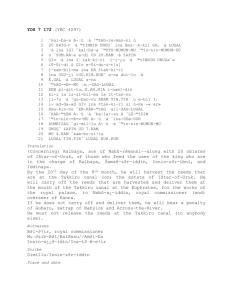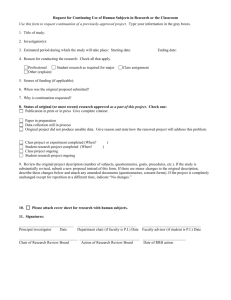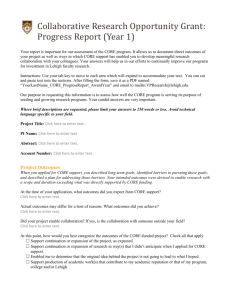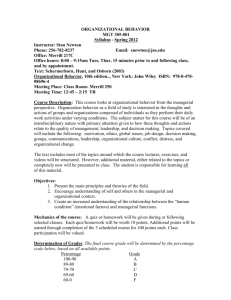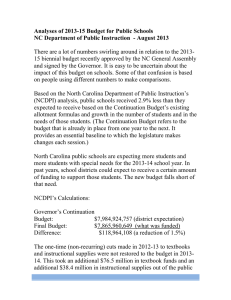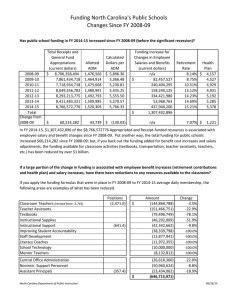G. Developing Alternatives for Future Officer Management Background
advertisement
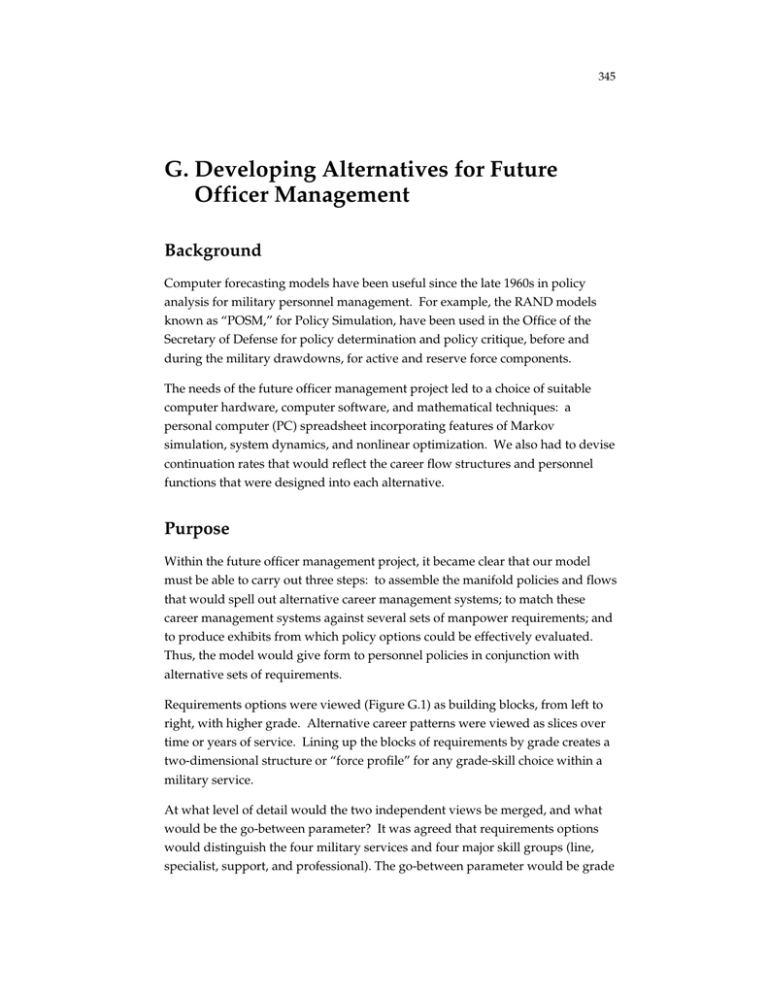
345 G. Developing Alternatives for Future Officer Management Background Computer forecasting models have been useful since the late 1960s in policy analysis for military personnel management. For example, the RAND models known as “POSM,” for Policy Simulation, have been used in the Office of the Secretary of Defense for policy determination and policy critique, before and during the military drawdowns, for active and reserve force components. The needs of the future officer management project led to a choice of suitable computer hardware, computer software, and mathematical techniques: a personal computer (PC) spreadsheet incorporating features of Markov simulation, system dynamics, and nonlinear optimization. We also had to devise continuation rates that would reflect the career flow structures and personnel functions that were designed into each alternative. Purpose Within the future officer management project, it became clear that our model must be able to carry out three steps: to assemble the manifold policies and flows that would spell out alternative career management systems; to match these career management systems against several sets of manpower requirements; and to produce exhibits from which policy options could be effectively evaluated. Thus, the model would give form to personnel policies in conjunction with alternative sets of requirements. Requirements options were viewed (Figure G.1) as building blocks, from left to right, with higher grade. Alternative career patterns were viewed as slices over time or years of service. Lining up the blocks of requirements by grade creates a two-dimensional structure or “force profile” for any grade-skill choice within a military service. At what level of detail would the two independent views be merged, and what would be the go-between parameter? It was agreed that requirements options would distinguish the four military services and four major skill groups (line, specialist, support, and professional). The go-between parameter would be grade 346 Number of officers RANDMR470-G.1 AAA AA AAA AAA AAA AAA AAA AAA AAA AAA AAA AAA AAA AAA AAAAAAAAAAAA Individuals Support Specialist Line O-1 to O-3 O-4 O-5 O-6 Figure G.1—Requirements Options Are Defined by Service and Grade and Skill (O-1 to O-3, O-4, O-5, O-6). Thus, the model would quantify how alternative careers were structured by year of service for each service and skill area. Within these careers, grade would be determined so that the total by grade would match the corresponding service-skill requirement option. Furthermore, by moving from one profile to another, the flows between skills (migration), and the flow from one requirements option to another (flexibility) would be treated. From the assembled profiles, the model would develop the data and exhibits to be used for evaluations. Continuation Rates Each career management alternative required selection of a corresponding set of continuation rates that shape the experience profiles shown in Section 6. The year-to-year continuation rates for each cohort jointly reflect voluntary and involuntary losses in the wake of career management policy. Continuation rates used in the career management alternatives are shown in the figures below using the Army as an example. We used service-specific continuation rates. The rates for Alternative A were developed from actual rates in the period FY 1987–FY 1989. In essence, we accepted cohort continuation rates experienced in the late 1980s as the basis for future behavior under a DOPMA-like alternative. (Some minor adjustments were made in rates if we perceived that late 1980s rates were affected in some manner by officer reductions that began in 1986.) Rates for all 347 RANDMR470-G.2 1.0 Continuation rates 0.8 0.6 0.4 Army FY1987–1989 Army Alternative A 0.2 0 1 6 11 16 21 26 31 36 Years of service Figure G.2—Army DOPMA Continuation Rates Compared with Alternative A: DOPMA Short other alternatives were derived by making adjustments to the rates in Alternative A. See Figure G-2. Alternatives B and C each provided a single major adjustment to DOPMA policy modeled in Alternative A. Alternative B extended maximum career length, and Alternative C allowed for lateral entry. We sought a boundary case of highest reasonable continuation rates in years of service likely to be affected by behaviors in these alternatives. Figure G.3 shows continuation rates for Alternative B in comparison to those of Alternative A using the Army as an example. We gradually stretched the profile of Alternative A until it extended by five years. In particular, we assumed career lengthening did not have an effect in years of service (YOS) 1–11; we began to stretch the career slightly in YOS 12 through 20 by using Alternative A continuation rates for YOS 11 to 19; we left initial retirement eligibility unaltered; we used Alternative A YOS 19 rates for Alternative B YOS 21 to 25 to provide the boundary case of high retention for five years because longer maximum careers should cause officers to stay at greater rates; we used the experienced retirement pattern of Alternative A YOS 21 to 29 for Alternative B YOS 26 to 34. While variations from this assumed pattern of continuation rates for Alternative B could easily be argued, we believe that our evaluations in Section 8 are at least a benchmark for any reasonable pattern of long careers and that at worst one 348 RANDMR470-G.3 1.0 Continuation rates 0.8 0.6 0.4 Army Alternative A Army Alternative B 0.2 0 1 6 11 16 21 26 31 36 Years of service Figure G.3—Army Continuation Rates in Alternative A Compared with Alternative B: DOPMA Long might shade toward the Alternative A results if the rates for YOS 21 to 25 are thought to be difficult to sustain voluntarily. For Alternative C, we also sought a boundary case of continuation rates for the lateral entrants at YOS 5 and at YOS 10 (while replicating continuation rates from Alternative A for YOS 1 entrants—see Figure G-4). In particular, for lateral entrants at YOS 5, we assumed losses comparable to Alternative A for YOS 5 to 9; we used the Alternative A YOS 9 rate for YOS 10 to 11 since involuntary (forced) losses were not expected because the lateral entrants had only 5 years of actual service at this point; we assumed comparable losses in YOS 12 to 19 as in Alternative A; we used Alternative A YOS 19 rates for YOS 20 to 24 because 5year lateral entrants could not yet retire; we used the Alternative A YOS 20 to 29 rates for YOS 25 to 34, reflecting the expected retirement loss pattern. For lateral entrants at YOS 10, we used Alternative A YOS 9 rates for YOS 10 to 11 and Alternative A YOS 12 to 19 for YOS 12 to 19 for the same reasons outlined above. We used Alternative A YOS 19 rates for YOS 20 to 29 because 10-year entrants could not yet retire; we used the Alternative A YOS 20 to 24 rates for YOS 30 to 34, reflecting the expected retirement loss pattern. Alternatives D and E provided for more than one major change in career management policy and therefore required a different approach from simple 349 RANDMR470-G.4 1.2 Continuation rates 1.0 0.8 0.6 Army Alternative A 0.4 Army Alternative C 0.2 0 1 6 11 16 21 26 31 36 Years of service Figure G.4—Army Continuation Rates in Alternative A Compared with Alternative C: Lateral Entry adjustment to the service-specific continuation rates experienced in the late 1980s under DOPMA. Our basic approach was to first sort out voluntary losses from involuntary ones. The voluntary continuation rates of the late 1980s were then to serve as a basis for defining 16 career patterns each of which was defined by a promotion pattern and a termination year of service. Thus, continuation rates were selected indirectly by placing constraints on the numbers of officers in each career pattern allowable for each alternative. The objective function for both alternatives was to minimize the difference between total inventory and the total requirement (including individuals). The specific constraints used to assemble the career patterns that result in the continuation rates portrayed for Alternatives D and E are described below. The constraints for both alternatives were • Meet aggregated O-1 to O-3 requirements across all skills and also for the line independently. • Meet O-4 to O-6 requirements by grade and skill. • Constrain fast-track career patterns to between 6 percent and 13 percent of total accessions; at least 3 percent of accessions were flag rank fast-track career patterns. 350 • To ensure that all allowed career patterns were used, each line career pattern (including those that would migrate eventually to other career fields) had to account for at least 5 percent of accessions (except fast track, which were constrained at 3 percent for both types and the O-3 exception explained below). Since no one was involuntarily separated in Alternative D, there was no minimum requirement for the career pattern representing individuals who were not promoted beyond O-3. Constraints for Alternative E only, which were used to create involuntary losses early in careers, were • The continuation rate into YOS 5 could not exceed 80 percent. • The continuation rate out of YOS 10 could not exceed 75 percent. Figure G.5 shows the resulting continuation rates for Alternative D, and Figure G.6 portrays them for Alternative E. In Alternative D, the effect of immediate retirement with a reduced annuity is observable at YOS 30; in Alternative E, this effect plus that of forced attrition at YOS 5 and 10 are observable. Additionally, in both alternatives continuation is greater between 5 and 10 YOS reflecting the opportunity to be vested at 10 YOS. Moreover, in Alternative E, forced attrition at YOS 5 would have removed earlier those who might normally have separated later. Those selected to stay would be presumed to do so at higher rates. RANDMR470-G.5 1.0 Continuation rates 0.8 0.6 0.4 Army Alternative A Army Alternative D 0.2 0 1 6 11 16 21 26 31 36 Years of service Figure G.5—Army Continuation Rates in Alternative A Compared with Alternative D: Long, Stable Careers 351 RANDMR470-G.6 1.0 Continuation rates 0.8 0.6 0.4 Army Alternative A Army Alternative E 0.2 0 1 6 11 16 21 26 31 36 Years of service Figure G.6—Army Continuation Rates in Alternative A Compared with Alternative E: Career Selection
